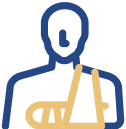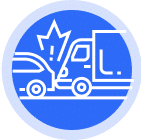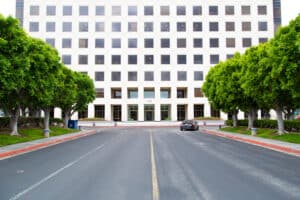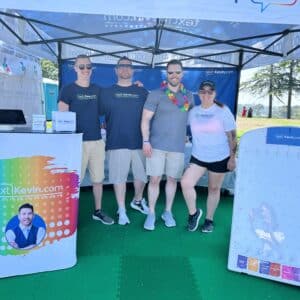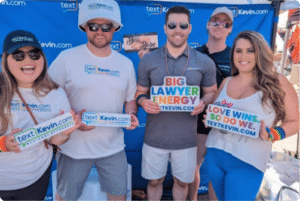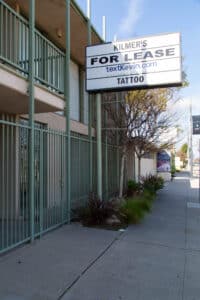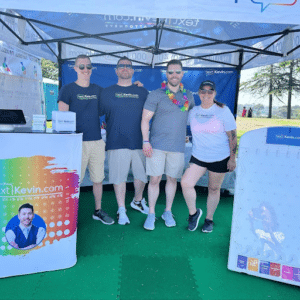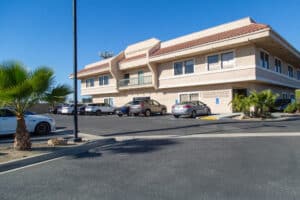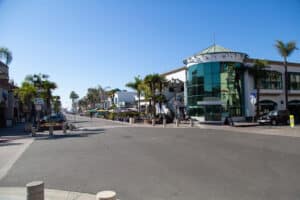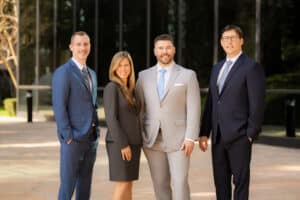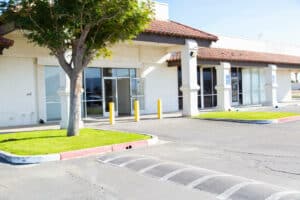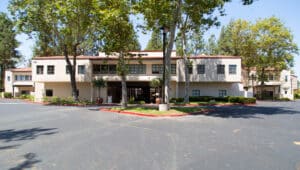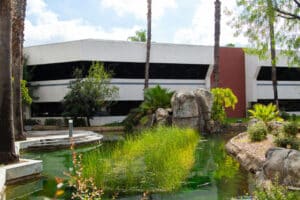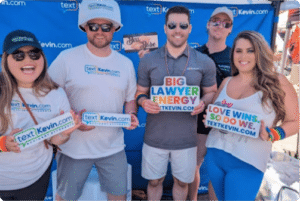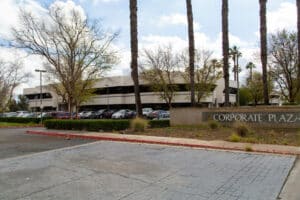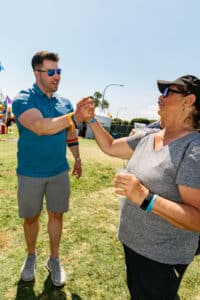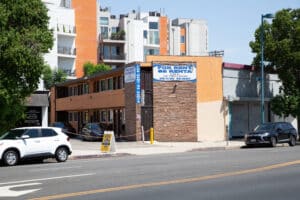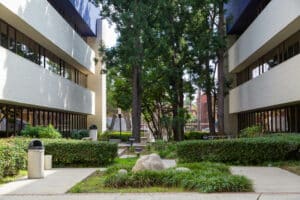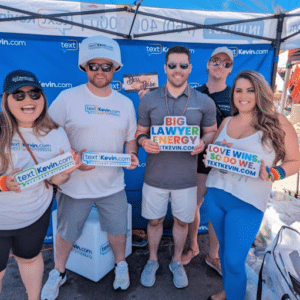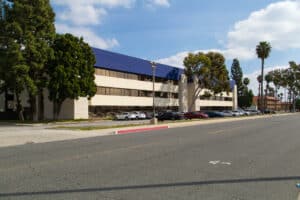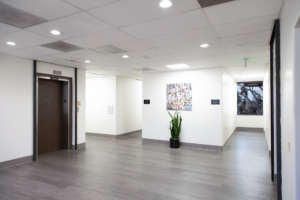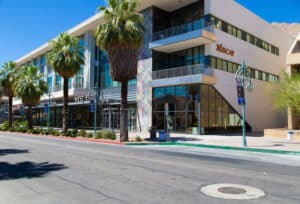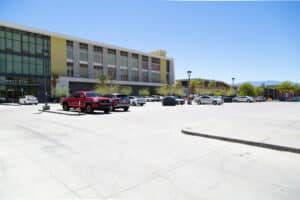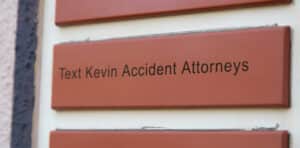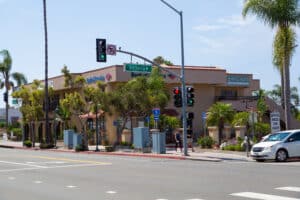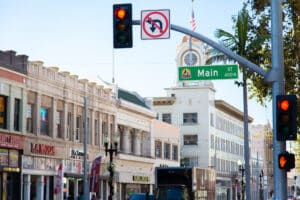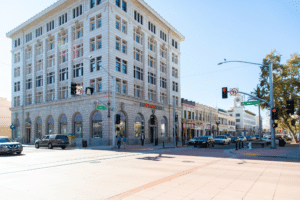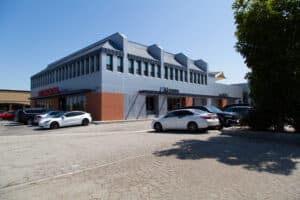Following a car accident in Ontario, finding experienced legal representation is everything. Crockett Law Group, led by Kevin Crockett, exclusively handles car accident cases, establishing itself as a premier Five-Star Rated Personal Injury Law Firm in Southern California.
We are proud of our achievements:
- Securing over $6 million in car accident cases.
- Earning more than 30 awards and honors, such as Lawyers Of Distinction 2020, The National Trial Lawyers Top 40 Under 40, and Super Lawyers 2021.
Kevin Crockett, raised in Southern California with top honors from the University of California, Irvine, has dedicated his career to personal injury law. This dedication ensures that each client receives dedicated and forceful representation.
Ontario Car Accident Statistics
The frequency of car accidents in California exceeds the national average. In 2022, the state saw more than 216,366 traffic-related incidents, leading to 3,854 fatalities and 165,978 injuries. This equates to approximately 520 individuals affected by car accidents daily across the state.
Total Injuries & Fatalities
- 2019: 866
- 2020: 168
- 2021: 677
- 2022: 621
- 2023: 645
Statistics on Fatal and Injury Causing Collisions in Ontario
Over the past five years, we’ve closely monitored the occurrence of fatal and injury-causing collisions in Ontario. In 2019, there were 866 reported incidents, while in 2023, the number reduced to 645, indicating a notable decrease of 26%. This trend suggests positive strides in road safety across the province. Despite fluctuations in intervening years, the overall decline signifies significant progress in mitigating accidents and protecting motorists and pedestrians alike.
Primary Collision Factor
- Right-of-Way: 166
- Unsafe Speed: 129
- Traffic Signals and Signs: 128
- Improper Turning: 90
- DUI: 49
- All Other: 83
Statistics on Common Causes of Collisions in Ontario
Analysis of collision data reveals a common thread: failure to yield the right of way emerged as the primary collision factor in many incidents. This recurring issue underscores the importance of driver awareness and adherence to traffic regulations. By neglecting to yield appropriately, drivers not only endanger themselves but also pose significant risks to others sharing the road.
Pro Tip
Investing in advanced driver assistance systems (ADAS) can enhance your vehicle’s safety features, potentially reducing the likelihood of accidents. However, always remember that ADAS systems are aids and not substitutes for attentive driving.
Which Roads and Intersections in Ontario Are the Most Dangerous?
Ontario, California, faces significant safety challenges at some of its intersections, notably at the off-set crossing of Grove Avenue and Fifth Street, which has been dubbed one of the city’s deadliest. The intersection’s dangerous reputation, highlighted by a series of fatal accidents, including the tragic loss of 15-year-old Jesse Valencia, has prompted city officials to promise action.
Grove Avenue and Fifth Street
The intersection’s unique design, where corners do not align traditionally, complicates navigation and has been a focal point of community concern for years. Despite previous efforts to enhance safety, including the installation of medians to restrict certain turning movements, accidents and close calls persist, underscoring the need for more effective solutions.
City’s Response and Community Feedback
In response to these ongoing safety issues, Ontario city officials have considered several measures. Among them is the installation of a traffic signal at the nearby Princeton Street and Grove intersection, expected to commence within six months. This action, however, comes after years of pleas from residents for more decisive intervention to mitigate the risks at Grove and Fifth.
Local voices, including business owners and postal workers who navigate these streets daily, have consistently highlighted the dangers posed by speeding and the inadequacy of current safety measures. The community’s suggestions have ranged from implementing a stoplight directly at the troubled intersection to lowering the speed limit, though challenges related to state laws and potential traffic congestion complicate these proposals.
Looking Forward
Councilman Alan Wapner’s acknowledgment of the need to potentially challenge state vehicle laws to prioritize resident safety marks a significant shift towards more proactive measures. The city’s commitment to finding a viable solution underscores the importance of balancing legal constraints with the urgent need for enhanced pedestrian and vehicular safety.
State St and Sultana: Another Problematic Intersection
Further compounding Ontario’s traffic safety issues is the intersection at State St and Sultana, characterized by a confusing layout exacerbated by proximity to railroad tracks and an unusually placed stop sign. This intersection’s design adds to the complexity of navigating Ontario’s roads and highlights the broader need for comprehensive traffic safety reforms across the city.
What Should I Do After a Car Accident in Ontario?
Following a car accident in Ontario, the actions you take can significantly impact your legal case:
Document the Accident
Thoroughly document the scene of the accident. Note the exact time, date, and location and pay attention to weather conditions and relevant traffic signs or signals. If possible, take extensive photographs or videos of the scene, including the positions of all vehicles involved, any visible damage, skid marks, and overall conditions. Gather contact information from all drivers and passengers and obtain the names and contact information of any witnesses who saw the accident occur.
Keep Records
Maintain meticulous records of everything related to the accident and its aftermath. This includes obtaining a copy of the official police report and collecting and organizing all your medical records detailing your injuries. Keep receipts for any accident-related expenses (such as medical bills, medication costs, transportation to appointments, and repair estimates). If you’ve missed work due to your injuries, carefully document those lost wages as well.
Follow Medical Advice
Prioritize your health and recovery. Strictly follow your doctor’s instructions. Attend all recommended appointments and take any prescribed medications as directed. Don’t miss any physical therapy or rehabilitation sessions. Demonstrating your commitment to your treatment plan strengthens your case by highlighting the seriousness of your injuries. Failing to follow medical advice could give the insurance company reason to downplay your injuries.
Notify Your Insurance
Contact your insurance company promptly to report the accident. However, proceed with caution when providing information. Stick to the basic facts of the accident and avoid admitting fault or giving extensive statements about your injuries. Insurance companies may try to use your words against you to minimize your claim, so it’s often wise to consult with a lawyer before providing a detailed recorded statement.
Preserve Evidence
It’s crucial to preserve evidence that supports your claim. Avoid repairing your vehicle immediately, as the insurance company needs to inspect the damage. Keep any damaged clothing or other personal items from the accident. Take photographs to document your injuries over time, as visible signs of trauma can be powerful evidence.
Call a Lawyer
Seek guidance from an experienced Ontario car accident lawyer as soon as possible. A lawyer will navigate the complex insurance claims process, protect your rights, and fight to ensure you receive the maximum compensation you deserve. They can assess the strength of your case and advise you on whether to pursue a settlement or take your case to court. Legal representation is particularly important if there are disputes about fault or if your injuries are severe.
We’ll Fight to Recover Compensation for All of Your Car Accident Injuries
Whiplash and Neck Injuries
Rear-end collisions are a frequent cause of whiplash and related neck injuries in Ontario. The sudden, violent jolt sends your head and neck out of alignment, straining delicate muscles, tendons, and ligaments. Initial symptoms like stiffness and pain could be just the start. Don’t ignore them, as whiplash can worsen over time. Seek medical evaluation right away for early diagnosis and treatment to prevent long-term issues. Treatment might include pain medication, physical therapy, and potentially a supportive collar.
Concussions and Traumatic Brain Injuries (TBIs)
Even minor-seeming fender benders in Ontario can cause serious brain injuries. The force can violently shake your brain inside your skull, damaging brain tissue. A concussion is one type of TBI. Symptoms vary greatly – from headaches and confusion to severe problems like seizures or lasting changes in personality. Never brush off any head injury after a crash – get checked by a doctor! Treatment plans are individualized and may involve rest, medication, and various therapies.
Broken Bones and Fractures
The impact of a car crash can easily break bones, especially in your arms, legs, and ribs. Breaks range from simple (where the bone cracks but stays aligned) to the dramatic compound fractures where the bone pierces the skin. Expect intense pain, swelling, and likely the inability to use the affected body part. Treatment depends on the severity and location of the break. Options include casts, pins to hold the bone in place, or even surgery. Healing time varies significantly.
Spinal Cord Injuries
These are among the most devastating consequences of a car accident, potentially leading to lifelong disability. Your spinal cord is the central communication pathway for your body. Damage to it, often caused by the impact of fracturing or shifting vertebrae, can disrupt signals between your brain and the rest of you. This can cause loss of sensation, weakness, or even paralysis. Care starts with stabilizing the spine to prevent further injury, followed by treatments to reduce inflammation and maximize potential recovery.
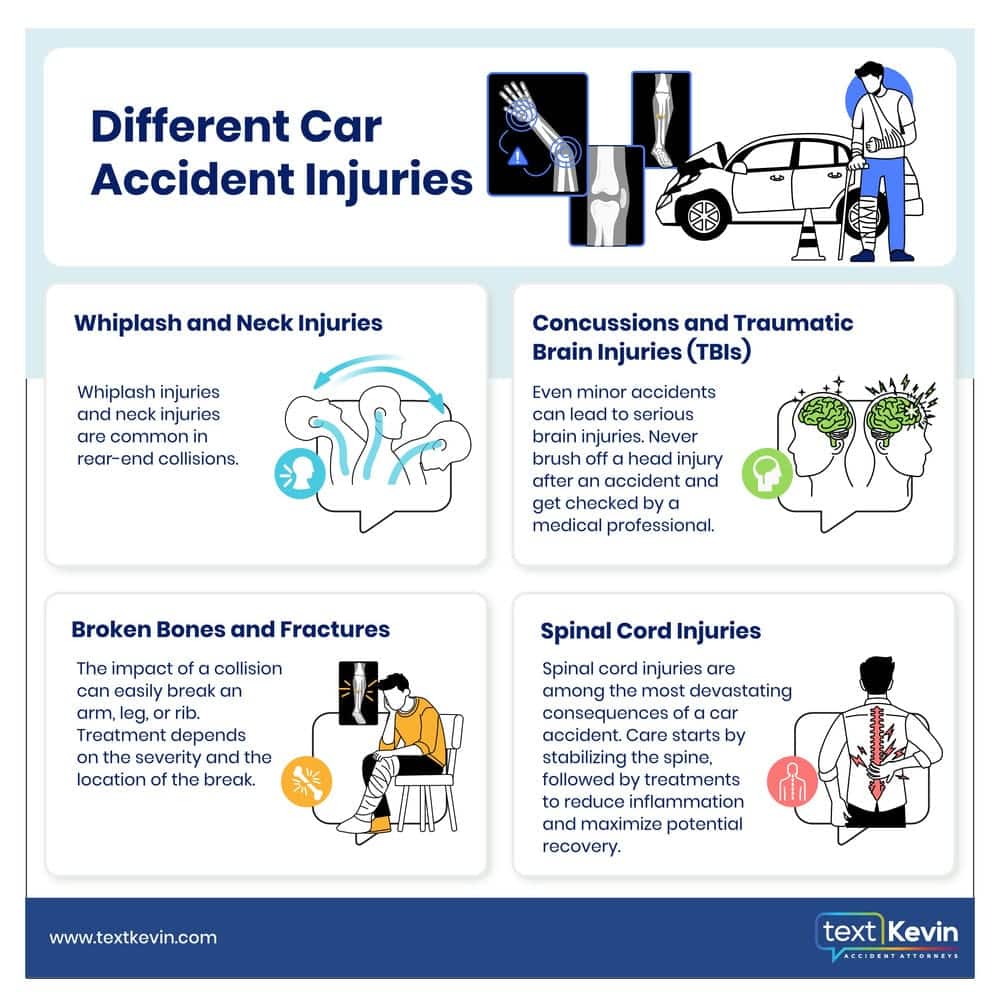
How Much Does It Cost to Hire a Car Accident Lawyer?
After an Ontario car accident, the financial aftermath can feel overwhelming, and you might be hesitant to hire an attorney due to worries about costs. Understandably, you’re already facing medical bills, vehicle repair expenses, and possibly lost wages while you recover.
At Crockett Law Group, we understand your situation. That’s why we operate on a contingency fee basis. This means you won’t pay any upfront legal fees. Our payment is contingent on winning your case – if we secure a settlement or award for you, our fees come from that. If we don’t win, you owe us nothing.
Local Results
Man Awarded $100,000 Settlement for Injuries Sustained in Ontario T-Bone Collision Caused by Red-Light Runner
| Case Type | Car Accident |
|---|---|
| Location | Ontario, CA |
| Settlement | $100,000.00 |
Can I Recover Compensation if I Share Some of the Blame for a Car Accident in Ontario?
It’s common to question whether you can still get compensation if you partially contributed to a car accident. Situations like this are more frequent than you might realize. For instance, imagine getting sideswiped at an intersection after making a turn without fully checking for oncoming traffic. While another driver might bear the primary fault, you might also share some responsibility.
California follows a “comparative negligence” system. This means that even if you made a mistake, you may still be eligible to recover compensation. However, the amount you receive will be reduced proportionally to your percentage of fault. For example, if a court determines you were 15% at fault, you could still recover 85% of your total damages.
Why Choose Crockett Law Group?
Selecting our firm means you benefit from:
- Comprehensive accident investigations to determine fault and liability.
- Assertive negotiations with insurance companies to ensure fair compensation.
- Access to a network of accident reconstruction experts and medical professionals.
- A commitment to securing the maximum compensation possible for your losses.
What Causes Car Accidents in Ontario, CA?
Factors leading to the high rate of car accidents in California include:
- Distracted Driving: A significant risk factor, including phone use behind the wheel.
- Speeding: Increases both the likelihood and severity of accidents.
- Driving Under the Influence (DUI): Impairs drivers’ abilities, raising the risk of accidents.
- Aggressive Driving: Behaviors like tailgating and unsafe lane changes contribute to accidents.
- Drowsy Driving: Similar to alcohol impairment, fatigue significantly reduces driving safety.
- Traffic Congestion: Increases accident likelihood, particularly with aggressive or impatient driving.
- Poor Road Design and Maintenance: Faulty intersection design and road disrepair can lead to accidents.
- Adverse Weather Conditions: Reduce visibility and road traction, elevating crash risks.
- Vehicle Malfunctions: Failures, such as brake issues or tire blowouts, can cause accidents.
Who Is Responsible for My Injuries?
Determining who is responsible for your injuries after a car accident involves a detailed analysis of the events leading up to the incident. Here’s a closer look at the parties potentially responsible and how fault is assessed:
Drivers
The most common cause of car accidents is driver error. This can include speeding, distracted driving, DUI, and failure to obey traffic laws. If another driver’s negligence caused the accident that resulted in your injuries, they could be held liable. Evidence such as police reports, witness statements, and traffic camera footage can be vital in establishing another driver’s fault.
Employers
If the at-fault driver was working at the time of the accident, their employer might also be liable under the legal doctrine known as “vicarious liability.” This principle holds employers responsible for their employees’ actions performed within the scope of their employment. For example, if a delivery driver causes an accident while making deliveries, the delivery company could be held responsible.
Tip
When dealing with accidents involving an at-fault driver who was working at the time, consider the legal principle of “vicarious liability.” Seeking guidance from a knowledgeable attorney can help navigate complexities and ensure all responsible parties are held accountable.
Manufacturers
Vehicle manufacturers or parts manufacturers may be liable if a defect in the vehicle or one of its components contributed to the accident. This could include faulty brakes, airbag failures, or tire blowouts. Liability in such cases typically falls under product liability law, which requires showing that the defective product directly caused your injuries.
Government Entities
Local, state, or federal government entities might be responsible if poor road conditions or inadequate signage contributed to the accident. For example, if an accident occurred at an intersection known to be dangerous without appropriate measures taken to enhance safety, the governmental body responsible for maintaining that road could be found liable.
Property Owners
In some cases, property owners could be responsible for accidents that occur due to hazards on their property that extend into the roadway, such as overgrown vegetation blocking sightlines at an intersection.
Comparative Negligence in California
California follows a “comparative negligence” rule, meaning that more than one party can be found at fault for an accident. Under this system, the compensation you’re entitled to receive can be reduced by a percentage equal to your share of fault. For instance, if you are found to be 20% at fault for the accident, your compensation will be reduced by 20%.
This law ensures that even if you partially contributed to the accident, you could still recover compensation for your injuries, though the amount may be adjusted to reflect your degree of fault.
What if I Am Hit by an Uninsured Driver?
If you are hit by an uninsured driver in California, you may have the following options to seek compensation for your damages and injuries:
- File an uninsured motorist claim with your own insurance company if you have this optional coverage. This can cover your medical expenses, lost wages, and property damage up to the limits of your policy.
- File a lawsuit against the uninsured driver if they have any assets that can be seized or garnished. However, this may be a difficult and costly process, and there is no guarantee that you will be able to collect the judgment.
- File a lawsuit against a liable third party, if any, such as the owner of the vehicle, the employer of the driver, or the manufacturer of a defective car part. This may depend on the specific circumstances of the accident and the evidence available.
In any case, you should always report the accident to the police, inform your insurance company, seek medical care, and consult with an experienced car accident lawyer in California to protect your rights and interests.
What Types of Damages Are Recoverable?
Victims are entitled to economic damages for quantifiable losses, non-economic damages for intangible losses, and, in extreme cases, punitive damages against the at-fault party for egregious behavior.
Economic Damages
Economic or special damages are those that have a specific monetary value associated with them. These are out-of-pocket expenses you have incurred or will incur as a direct result of the accident.
Economic damages include:
- Medical Expenses: This can cover past, current, and future medical treatments related to injuries sustained in the accident. It includes hospital stays, doctor visits, physical therapy, medication costs, and any long-term care needs.
- Lost Wages: Compensation for the income you lost while recovering from your injuries. If the injuries impact your ability to earn a similar income in the future, you can also claim loss of earning capacity.
- Property Damage: Reimbursement for the repair or replacement of your vehicle and any other personal property damaged in the accident.
- Other Out-of-Pocket Expenses: Any other costs incurred because of the accident, such as transportation to medical appointments or hiring help for household duties you’re unable to perform because of your injuries.
Non-Economic Damages
Non-economic or general damages compensate for losses that don’t have a direct monetary value but significantly impact your life.
These include:
- Pain and Suffering: Compensation for the physical pain and emotional distress you experience due to your injuries. This can also cover anxiety, depression, loss of enjoyment of life, and other psychological effects.
- Loss of Consortium: Damages awarded to the spouse or close family members for the loss of companionship, affection, support, and, in the case of a spouse, sexual relations, due to the injuries.
- Disfigurement: Compensation for permanent physical changes that affect your appearance and possibly your self-esteem.
- Loss of Life’s Enjoyment: Damages for the inability to enjoy hobbies and recreational activities you engaged in before the accident.
Punitive Damages
Punitive damages are less common and are not awarded for the purpose of compensating the victim. Instead, they are intended to punish the at-fault party for particularly reckless or malicious behavior and to deter similar conduct in the future. For example, punitive damages might be considered if the defendant was driving under the influence of alcohol or drugs at the time of the accident.
Note
Punitive damages can be significant in cases involving egregious misconduct, such as driving under the influence. While they are not intended to directly compensate the victim, their imposition can act as a deterrent against similar behavior in the future and may play a role in achieving justice beyond mere compensation.
What Damages Are Available to Recover?
The amount of damages awarded in a car accident case can vary widely based on the specifics of the case, including the severity of the injuries, the impact on the victim’s life, and the defendant’s conduct. Economic damages are relatively straightforward to calculate based on bills and financial records. In contrast, non-economic damages are more subjective and require thorough documentation and sometimes expert testimony to quantify. Punitive damages, when applicable, are determined by the court based on the egregiousness of the defendant’s actions.
How Much Is My Case Worth?
The worth of your car accident case is influenced by the severity of your injuries, the extent of your damages, liability issues, and the evidence strength. Consulting with a skilled personal injury lawyer is advised for accurately evaluating your case and maximizing your compensation.
We Handle All Types of Car Accidents in Ontario
Our firm is equipped to manage various car accident cases, from rear-end collisions to complex multi-vehicle accidents, ensuring robust representation regardless of the accident type.
How Long Do I Have to File a Lawsuit in California?
California law sets a two-year statute of limitations for car accident lawsuits, with certain exceptions potentially extending this period under specific circumstances.
I had the privilege of working with Kevin, a personal accident attorney, to address my injury-related concerns. He ensured I received the compensation I deserved. Thank you, Kevin!
Patrick Pierre
California Accident Victim
Ontario Accident FAQs
Here are answers to some frequently asked questions that can guide you through this process.
Yes, a minor can be sued for a car accident in California. However, the lawsuit is typically filed against the minor’s parents or guardians under the California Family Code Section 6710, which holds parents or guardians liable for the willful misconduct of a minor that results in injury or death, or property damage.
Whether it’s worth suing for whiplash depends on the severity of the injury and its impact on your life. If whiplash causes significant pain, medical expenses, lost wages, or long-term suffering, pursuing a lawsuit can be a viable option to recover damages. Consulting with a personal injury attorney can help determine the strength of your case.
The timeframe for an insurance company to make an offer can vary widely depending on the complexity of the case, the thoroughness of the investigation required, and the company’s policies. Generally, it can take anywhere from a few weeks to several months after filing a claim to receive an initial settlement offer.
A doctor cannot feel a herniated disc through a physical examination alone. Diagnosis typically requires imaging tests such as MRI (Magnetic Resonance Imaging) or CT scans, which can provide detailed images of the spine’s condition, including any herniated discs.
In California, the statute of limitations for personal injury claims, including car accidents, is two years from the date of the injury. This means you have two years to file a lawsuit to seek compensation. However, it’s advisable to start the claim process as soon as possible to ensure evidence is preserved and your case is strong.
California law requires drivers involved in an accident that results in injury, death, or property damage exceeding $1,000 to report the incident to the California Highway Patrol or local police department within 24 hours. Failure to report can result in a misdemeanor charge, potential fines, and suspension of your driver’s license. Additionally, failing to report an accident to your insurance company in a timely manner could jeopardize your claim.
Contact an Ontario Car Accident Lawyer at Crockett Law Group
If you or a loved one has been involved in a car accident in Ontario, reach out to the Crockett Law Group for a free consultation. Our representation can make a significant difference in the outcome of your case. Call us today at (888) 965-3827 to see how we can assist you.
Ontario FAQs
Closing times at Ontario Mills vary depending on the day of the week and the season. It’s always best to check their official website for the most up-to-date hours of operation.
Ontario offers a variety of attractions! Explore the shops and restaurants at Ontario Mills, visit the Museum of History and Art, enjoy outdoor activities at Cucamonga-Guasti Regional Park, or catch a race at the Auto Club Speedway.
Ontario is located approximately 35-40 miles east of Downtown Los Angeles. Driving time can range from 45 minutes to over an hour depending on traffic conditions.
Ontario International Airport (ONT) is located at 2500 E Airport Dr, Ontario, CA 91761. It’s a major airport serving the Inland Empire region of Southern California.
Ontario Airport offers various parking options with different rates. You can find short-term, long-term, and economy lots. Check the airport’s website for current pricing and availability.
Ontario has an estimated population of over 185,000 residents, making it one of the larger cities in the Inland Empire region.
Ontario Points of Interest
A popular shopping mall with a wide range of retail stores and entertainment options.
Location: 1 Mills Cir, Ontario, CA 91764
Website: simon.com
A historic olive-packing facility offering tours and a gift shop.
Location: 315 E 4th St, Ontario, CA 91764
Website: graberolives.com
A venue for conferences, events, and trade shows.
Location: 2000 E Convention Center Way, Ontario, CA 91764
Website: gocvb.org
A recreational park with a lake, fishing, and picnic areas.
Location: 800 N Archibald Ave, Ontario, CA 91764
Website: parks.sbcounty.gov
Showcases the history and culture of the region through exhibits and artifacts.
Location: 225 Euclid Ave, Ontario, CA 91762
Website: ontariomuseum.org
A central gathering place with outdoor events, concerts, and community activities.
Location: 224 N Euclid Ave, Ontario, CA 91762
Website: ontariotownsquare.org
Ontario Auto Body Shops
Location: 4930 Vanderbilt St, Ontario, CA 91761
Website: fixautousa.com
Location: 1455 S Cucamonga Ave, Ontario, CA 91761
Website: caliber.com
Location: 611 W Holt Blvd, Ontario, CA 91762
Website: seidnerscc.com
Location: 1405 S Cucamonga Ave, Ontario, CA 91761
Website: crashchampions.com
Location: 424 S Bon View Ave, Ontario, CA 91761
Website: medinascollisioncenter.com
Location: 636 E State St, Ontario, CA 91761
Website: bestcollisionservicesinc.com
Ontario Neighborhoods We Serve
- Champagne
- Guasti
- Ontario Ranch



